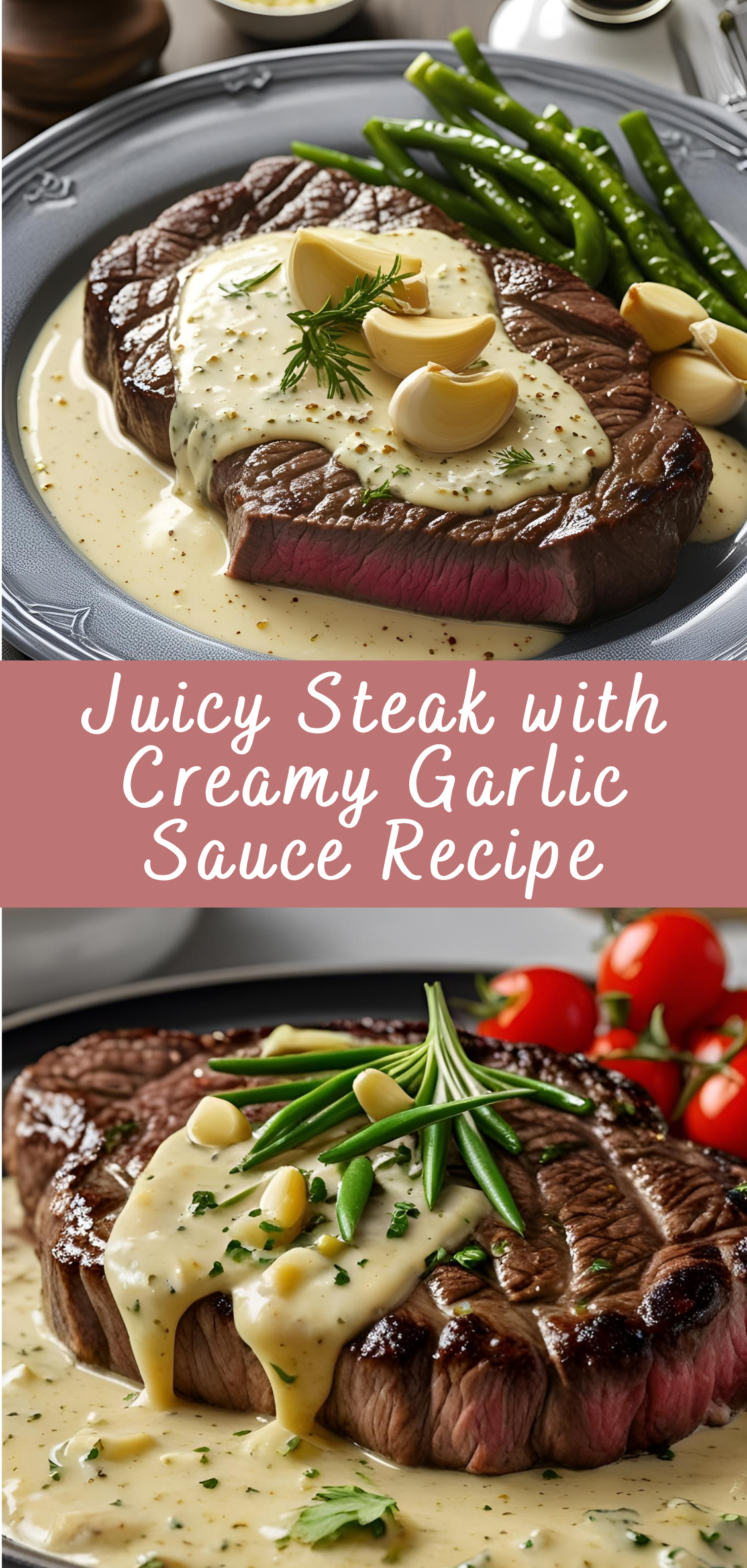Juicy Steak with Creamy Garlic Sauce Recipe
There is something undeniably satisfying about a perfectly cooked steak—crisp on the outside, tender and juicy on the inside, and full of rich, meaty flavor. While steak on its own can be a masterpiece, pairing it with a creamy garlic sauce elevates the dish to something truly luxurious. Whether you’re preparing a special dinner for guests or indulging in a weekend treat for yourself, a juicy steak accompanied by a velvety garlic-infused sauce delivers both comfort and elegance in every bite.

Steak has long held a place of honor on tables around the world. From the refined steakhouses of New York and Buenos Aires to the backyard grills of suburban homes, it remains a symbol of culinary satisfaction. But while steak preparation can be simple at its core, achieving that perfect combination of seared crust and succulent interior requires a balance of technique, timing, and quality ingredients. Add to that a thoughtfully crafted sauce—one that melds the boldness of garlic with the soothing richness of cream—and you have a dish that celebrates both tradition and indulgence.
The magic of this recipe lies not just in its flavors, but in the experience it creates. The moment the pan hits the heat and the steak begins to sizzle, there’s an anticipation that builds. As the aroma of garlic mingles with butter and cream, it becomes more than just dinner—it’s an event. It invites conversation, appreciation, and even a moment of silence as the first bite melts in your mouth.
In this comprehensive recipe guide, we will explore every step required to master this iconic pairing—from selecting the right cut of meat and understanding the nuances of seasoning to creating a garlic sauce that complements rather than overpowers. We’ll walk through cooking techniques suitable for both novice home cooks and experienced kitchen enthusiasts. Along the way, we’ll provide tips on equipment, timing, temperature control, and even plating, ensuring your final dish doesn’t just taste amazing—it looks and feels gourmet.
But this guide goes beyond a simple how-to. We’ll also delve into the history of steak as a cultural staple, the role of garlic in global cuisine, and how cream-based sauces became synonymous with French culinary influence. You’ll learn why certain methods work better than others, how small details make big differences, and how to make adjustments based on dietary preferences or available ingredients.
Ultimately, cooking is not just a task—it’s a dialogue between ingredients, technique, and the senses. And this dish, with its contrast of textures and harmonious blend of bold and delicate flavors, offers one of the most satisfying conversations you can have on a plate. Whether you’re looking to impress guests, treat a loved one, or simply enjoy a restaurant-quality meal at home, this recipe will guide you through the process with clarity and confidence.
In the sections that follow, we’ll break down the preparation into manageable parts, starting with ingredient selection and moving all the way through to the final presentation. So sharpen your knives, fire up your stovetop, and prepare to bring the steakhouse experience into your own kitchen—with a creamy garlic twist that just might steal the spotlight.
Part 1: Ingredients and Equipment
Before diving into the cooking process, it’s important to understand that the success of this dish relies heavily on choosing the right ingredients and using the proper tools. Quality matters. Even the simplest dish can become exceptional when built on a foundation of fresh, high-grade components and well-maintained equipment.
A. Key Ingredients
1. Steak
Recommended cuts:
-
Ribeye: Richly marbled and flavorful; excellent for pan-searing.
-
New York Strip: Leaner than ribeye but still tender with a bold beef flavor.
-
Filet Mignon: Extremely tender; a luxurious choice but less fatty.
-
Sirloin: A more affordable option with good flavor, though slightly chewier.
Key considerations:
-
Choose steaks that are at least 1 to 1½ inches thick. Thinner steaks cook too quickly and can dry out.
-
Look for visible marbling—the small white streaks of fat running through the meat—which adds juiciness and flavor.
-
Let your steak come to room temperature before cooking. This ensures even cooking and prevents a cold center.
2. Salt and Pepper
Use coarse kosher salt or sea salt and freshly ground black pepper. Fine salt can make it too salty and doesn’t create the same crust. The salt should draw moisture out and enhance the sear, while pepper adds that subtle bite.
3. High-Smoke-Point Oil
Use oils that can withstand high heat:
-
Canola oil
-
Avocado oil
-
Grapeseed oil
Avoid olive oil for the initial sear as it smokes easily and may burn.
4. Butter
Butter is used in the final phase of searing and basting. It adds richness and helps brown the steak while infusing it with flavor. Use unsalted butter so you can control salt levels.
5. Garlic
For the garlic sauce, use fresh garlic cloves. You’ll need:
-
Whole cloves for basting the steak
-
Minced or finely chopped garlic for the creamy sauce
Avoid pre-minced garlic in jars; it lacks the same pungency and depth.
6. Fresh Herbs (Optional but Recommended)
-
Thyme
-
Rosemary
-
Parsley
Used for both basting and finishing. They add earthy, aromatic notes that elevate the dish.
7. Heavy Cream
Full-fat heavy cream is essential for a thick, luscious sauce. Avoid half-and-half or milk, as they will not reduce or emulsify properly.
8. Parmesan Cheese (Optional)
Grated Parmesan adds umami and thickness to the sauce, especially if you want to turn it into more of an Alfredo-style garlic sauce.
9. Dijon Mustard (Optional)
A small spoonful adds a layer of complexity and helps emulsify the cream sauce without overpowering the garlic.
10. Beef or Chicken Stock
Used to deglaze the pan and deepen the flavor of the sauce. Low-sodium stock is ideal so the sauce doesn’t become too salty.
B. Essential Equipment
1. Cast Iron Skillet or Heavy-Bottomed Pan
A cast iron skillet is the gold standard for steak. It retains and distributes heat evenly, helping develop a rich, crusty sear. Avoid non-stick pans—they don’t get hot enough.
2. Tongs
For flipping the steak and basting safely without piercing the meat.
3. Meat Thermometer
If you’re not confident in judging doneness by feel, a thermometer is a game-changer:
-
Rare: 120–125°F (49–52°C)
-
Medium Rare: 130–135°F (54–57°C)
-
Medium: 140–145°F (60–63°C)
-
Medium Well: 150–155°F (65–68°C)
-
Well Done: 160°F+ (71°C+)
4. Sharp Chef’s Knife
For trimming fat, mincing garlic, and slicing the steak after it rests.
5. Cutting Board
Use a board with grooves to catch juices when resting and slicing your steak.
6. Saucepan
A small or medium-sized pan for preparing the garlic cream sauce. Stainless steel is ideal, as it allows for better heat control during reduction.
Part 2: Step-by-Step Cooking Instructions
Now that your ingredients and tools are ready, it’s time to get cooking. This process is broken down into key stages: prepping, searing, basting, resting, and saucing.
Step 1: Preparing the Steak
-
Bring to Room Temperature
Remove the steak from the fridge at least 30–45 minutes before cooking. This step is vital for even cooking. -
Trim Excess Fat
If your steak has large chunks of external fat, trim them down slightly. Leave a little on for flavor. -
Season Generously
-
Pat the steak dry with paper towels.
-
Season both sides liberally with kosher salt and cracked black pepper.
-
Press the seasoning into the meat so it adheres.
-
-
Optional Dry Brine
If you have time, salt the steak and leave it uncovered in the fridge for 1–2 hours. This dry brine pulls moisture out, helps form a better crust, and enhances flavor.
Step 2: Searing the Steak
-
Preheat Your Pan
Place your cast iron skillet over high heat for at least 5 minutes. It should be smoking hot before the steak touches it. -
Add High-Heat Oil
Pour in 1–2 tablespoons of your chosen oil and swirl to coat the pan. -
Place Steak in the Pan
-
Lay the steak away from you to avoid splatters.
-
Do not move the steak once it’s down—let the crust form.
-
-
Sear for 2–3 Minutes Per Side
-
Use tongs to flip only once when the crust is deeply browned.
-
If using a thick cut, sear the sides as well by holding it upright with tongs.
-
Step 3: Butter Basting and Aromatics
-
Lower Heat to Medium
Once both sides are seared, reduce heat slightly. -
Add Butter and Aromatics
-
Add 2–3 tablespoons of butter to the pan.
-
Toss in a few crushed garlic cloves and sprigs of rosemary or thyme.
-
-
Tilt the Pan and Baste
-
Tilt the pan so the butter pools on one side.
-
Use a spoon to scoop the butter and pour it repeatedly over the steak.
-
Continue basting for 1–2 minutes. This adds flavor and helps finish the cooking process.
-
Step 4: Checking Doneness
-
Use a Thermometer
Insert into the thickest part of the steak from the side.-
Remove the steak when it’s 5°F below your desired final temperature, as it will rise while resting.
-
-
Finger Test (Optional)
For experienced cooks, the touch test works:-
Rare: Soft and squishy
-
Medium: Springs back slightly
-
Well Done: Firm
-
Step 5: Resting the Steak
-
Remove from Pan
Place on a cutting board and loosely tent with foil. -
Rest for 8–10 Minutes
This allows the juices to redistribute, making the steak juicy rather than dry.
Step 6: Making the Creamy Garlic Sauce
-
Remove Excess Fat from Pan
Pour off most of the grease, leaving about 1 tablespoon and the browned bits. -
Sauté Garlic
-
Add 1–2 tablespoons of minced garlic to the pan.
-
Sauté on medium heat until fragrant and golden—not brown (about 30–60 seconds).
-
-
Deglaze with Stock
-
Pour in ¼ cup of beef or chicken stock.
-
Scrape up browned bits with a wooden spoon for extra flavor.
-
-
Add Cream
-
Stir in ¾ cup of heavy cream.
-
Bring to a gentle simmer—do not boil.
-
-
Optional Add-Ins
-
Add 1 teaspoon Dijon mustard for tang.
-
Stir in 2 tablespoons grated Parmesan for richness.
-
-
Simmer Until Thickened
-
Cook for 5–7 minutes, stirring often.
-
The sauce should coat the back of a spoon.
-
-
Season to Taste
Add salt and pepper as needed. A touch of nutmeg or lemon zest can also enhance the flavor.
Step 7: Serving the Steak
-
Slice the Steak
-
Slice against the grain to keep it tender.
-
Arrange slices on a plate or serving platter.
-
-
Drizzle Sauce Over the Steak
Spoon the creamy garlic sauce over the top or serve it on the side in a ramekin. -
Garnish
-
Finish with chopped parsley or a sprig of rosemary.
-
Serve with mashed potatoes, roasted vegetables, or a fresh green salad.
-
Juicy Steak with Creamy Garlic Sauce Recipe
There is something undeniably satisfying about a perfectly cooked steak—crisp on the outside, tender and juicy on the inside, and full of rich, meaty flavor. While steak on its own can be a masterpiece, pairing it with a creamy garlic sauce elevates the dish to something truly luxurious. Whether you're preparing a special dinner for guests or indulging in a weekend treat for yourself, a juicy steak accompanied by a velvety garlic-infused sauce delivers both comfort and elegance in every bite.
Ingredients
- For the Steak:
- 2 ribeye or sirloin steaks (1 to 1½ inch thick, about 8 oz each)
- Salt and black pepper, to taste
- 1 tbsp olive oil
- 1 tbsp unsalted butter
- 2–3 cloves garlic, smashed
- A few sprigs of fresh thyme or rosemary (optional)
- For the Creamy Garlic Sauce:
- 1 tbsp butter (or leftover steak drippings)
- 4 cloves garlic, minced
- 1 cup heavy cream
- ¼ cup grated Parmesan cheese
- Salt and pepper, to taste
- Optional: ½ tsp Dijon mustard or 1 tsp Worcestershire sauce for extra depth
Instructions
1. Prepare the Steak:
- Bring steaks to room temperature (about 20–30 minutes).
- Pat dry with paper towels and season both sides generously with salt and pepper.
2. Cook the Steak:
- Heat olive oil in a heavy skillet (cast iron preferred) over medium-high heat.
- Add steaks and sear for about 3–4 minutes per side for medium-rare, adjusting time based on thickness and desired doneness.
- During the last minute, add butter, smashed garlic, and herbs. Spoon the melted butter over the steak to baste.
- Remove steaks from pan, cover loosely with foil, and rest for 5–10 minutes.
3. Make the Creamy Garlic Sauce:
- In the same pan (do not clean), reduce heat to medium. Add a bit of butter if needed.
- Sauté minced garlic for 1–2 minutes until fragrant (not browned).
- Pour in heavy cream, stir, and simmer for 2–3 minutes.
- Add Parmesan and stir until melted. Season with salt, pepper, and optional mustard/Worcestershire.
- Let sauce thicken slightly (another 1–2 minutes), then remove from heat.
4. Serve:
- Slice rested steak against the grain.
- Spoon creamy garlic sauce over the steak.
- Serve with mashed potatoes, roasted veggies, or crusty bread.
Notes
- Steak Doneness Guide:
Use an instant-read thermometer for accuracy:
Rare: 125°F (52°C)
Medium-rare: 135°F (57°C)
Medium: 145°F (63°C)
Well-done: 160°F (71°C) - Pan Sauce Tip: Deglazing with a splash of white wine or beef broth before adding cream adds depth.
- Garlic Lovers: Add roasted garlic cloves to the sauce for even more flavor.



